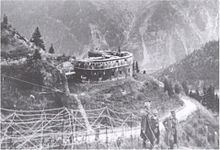Strino plant
The Strino plant (called Forte Strino a Velon by the Italians ) was one of a total of four barriers of the Austro-Hungarian fortress bar in Subrayon II of the Tonale barrier group .
Geographical location
It is the most secluded fort of the Sperrgruppe and is located at 1,500 meters above sea level directly on the Tonalepas road in the autonomous province of Trento . It is flanked to the south by the Presanella plant and to the north by the Mero and Tonale plants .
task
After the road to the Tonale Pass (Passo Tonale), which had previously existed at the level of a cart path, had been upgraded to an efficient connection at the instigation of Field Marshal Radetzky , one suddenly became aware of the danger that an Italian breakthrough over the pass height (also for the fortress of Trento ) would bring with it. The blocking group established afterwards (initially only the Strino plant) therefore had the task of sealing off the Val di Vermiglio and thus also the Val di Sole .
The construction
Erected in the years 1860–1862, when the First World War broke out , the plant no longer met the requirements of the time. The towering, two-storey block construction made it an ideal target for the enemy artillery. The structure was made of granite stones and laid out with the semicircular front and the recessed flanks typical of that time. Originally, the factory ceilings were only about one meter thick and covered with a layer of soil up to two meters high, which was sufficiently dimensioned for the shells of the time. In 1915 it was only considered barely shell-proof and less storm-free. Since the bottom of the valley could not be adequately secured with the factory guns, the support system "Vermigliohang melee system" was built in 1891 below the Strino factory and below the road. This was with a concrete postern with the guard house, which was also built at that time, directly next to the street (is still there) and from there connected to the main plant. Organizationally, the Vermigliohang melee system and a flanking system further down belonged to the Strino plant and were not independent units.
Armament
- Strino plant
- four 12 cm M 61 casemate cannons in depression mounts
- four 9 cm casemate cannons M 75/96
- Vermigliohang melee system
- two 8 cm M 98 minimal chart cannons
- two machine guns M 07/12
- seven rifle mounts
This facility was classified as shell-proof and storm-free.
crew
- a detachment of the Bolzano State Rifle Regiment No. II
- 2nd company of the fortress artillery battalion 7
Warlike events
In 1915 the Strino complex was no longer of any great combat value and was only used as accommodation and relay station. Since the front was on the Tonale Pass (eight kilometers as the crow flies) throughout the war, Strino was not involved in any direct combat operations. Italian artillery bombarded the Ponte di Legno factory and did some damage.
After the end of the war, the fort was used as a quarry by the returning residents of the Val di Vermiglio to rebuild their destroyed houses.
A few years ago, a private initiative began to restore the building as much as possible to its original state. The structure of the building itself had not suffered and the severe damage was only external, so that repairs are possible.
literature
- Erwin Anton Grestenberger: Imperial and Royal fortifications in Tyrol and Carinthia 1860–1918 . Verlag Österreich ua, Vienna 2000, ISBN 3-8132-0747-1 .
- Rolf Hentzschel: Austrian mountain fortresses in the First World War. The Folgeria and Lavarone plateaus . Athesia, Bozen 1999, ISBN 88-8266-019-2 , ( Athesia workshop. Non-fiction book ).
- Wilhelm Nussstein: Dolomites. Austrian fortresses in Northern Italy. From the seven municipalities to the Flitscher Klause . Mittler, Hamburg et al. 1997, ISBN 3-8132-0496-0 , ( military history travel guide ).
- Compass Carta turistica: Adamello-Presanella . Compass Fleischmann S.ar.I. Instituto Geografico, I-38014 Gardolo (Trento)
Coordinates: 46 ° 16 ′ 46 ″ N , 10 ° 38 ′ 35 ″ E



